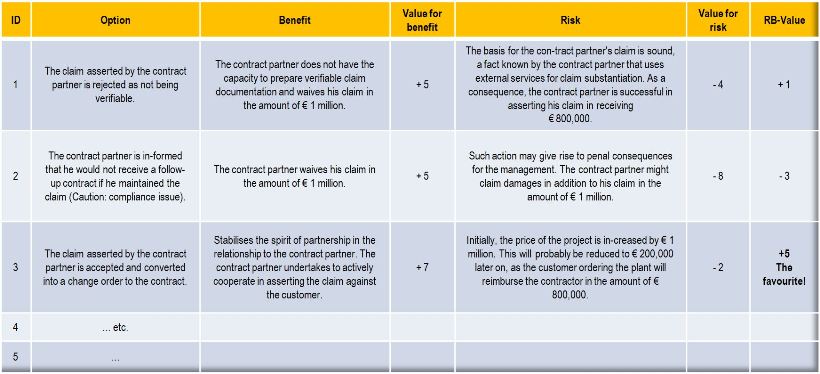Claims-Management-Strategy: Structured decision-making-process in claim situations

FOR-DEC. A decision-making model from manned aviation adapted to claims management in industrial projects.
2017-09-15. FOR-DEC is a method for structured decision-making in manned aviation developed by members of the staff of the German Aerospace Center (DLR). The FOR-DEC method aims at making decisions in a dynamic environment which are not influenced by precipitate impulses and are not based on the gut feeling of individual actors.
The letters of the acronym FOR-DEC describe the individual steps leading to solid decisions and stand for:
- Facts: Which verifiable facts characterise the situation to be solved?
- Options: Which courses of action are available in this situation?
- Risks & Benefits: Which risks and benefits are inherent in any course of action identified above?
- - THE HYPHEN: This is the moment to pause before deciding on the further course of action and implementing the measures required. The hyphen, the moment to pause, is important to prevent that essential aspects of the situation to be solved are missed in the hectic of events.
- Decision: Choice of a course of action.
- Execution: Implementation of a course of action.
- Check: Checking if the implementation of the course of action chosen will lead to success.
When using this FOR-DEC method, it is important not to lose sight of the time factor in taking decisions. Where time constraints are highly important, a course of action must be chosen offering maximum increase in security.
„In project management, we do not fly“
It sounds logical and comprehensible what the FOR-DEC method offers in providing support to pilots in aviation with its ultimate goal of perfect safety of "men and equipment". But what does this have to do with claims management in the context of executing industrial projects?
Both in aviation and in project management people are faced with the necessity to cope with new and complex situations every day having to take important decisions under great time pressure. „My gut feeling tells me that ….“, says the seasoned project director and takes an intuitive decision.
In intuitive decision making, two heuristics are of major importance: „similarity matching“ and „frequency gambling“ as termed by James Reason, a British psychologist of Manchester University. Both heuristics aim at taking quick decisions on the basis of experience gained to date. They, however, imply as well that information on the current situation is neglected, as only patterns of more or less comparable situations in the past are considered. This approach has been termed: „best practise“.
„Best Practises“ in claims management - a curse or a blessing?
„Groundhog Day“ - that is the title of a critical article in Peter Addor's blog, a Swiss mathematician and systems theoretician, on the subject "best practises" and their applicability in day-to-day project activities. Among other things, Peter Addor writes:
„You know how to deal with frequent situations. You are familiar with them and know from experience how to act. I have, for example, often come across icy forest paths and know how to walk without falling down. But I have never come across a covered hole on such paths. I do not have any experience with such holes and would probably just fall in! If I passed such covered holes every day, I would develop a sensitivity for discovering and bypassing such holes“.
Translated into situations occurring every day in project management, this simply means that in claims management blind trust in the effectiveness of „best practises" must not necessarily function well enough to prepare for contingencies. Everyone in project management surely knows about „covered holes on familiar forest paths".
FOR-DEC adapted to claims management in day-to-day project activities.
Should a situation arise where a claim asserted by a contract partner (in the present case a subcontractor of the contracting engineering company) is to be defended against, it would make sense to …:
- … clarify the relevant facts with the members of the team directly involved in such claim:
- What are the facts which gave rise to the claim?
- How are the facts documented by our own company? Verifiability!
- How are the facts documented by the contract partner asserting the claim? Verifiability!
- How serious are the effects (money, construction time) of the contract partner's claim for our own company?
- Which are the contractual provisions the contract partner bases his claim on? Clarity! Validity!
- On which contractual basis can the claim asserted by the contract partner be defended against? Clarity! Validity!
- To what extent is our own company dependent on the contract partner?
- To what extent is the claiming contract partner dependent on our company?
- ...identify the courses of action („Options“):
- The claim asserted by the contract partner is strongly rejected without giving any reasons.
- The claim asserted by the contract partner is rejected as not being verifiable.
- The contract partner is informed that he would not receive a follow-up contract if he maintained the claim (Caution: compliance issue).
- The claim asserted by the contract partner is accepted and converted into a change order to the contract.
- No answer is given to the contract partner hoping that he will change his opinion and abandon the claim („waiting for the problem to resolve itself“).
- The contract partner is put off and told that this claim will be settled in the negotiations on the final invoice for the project.
- The contract partner is confronted with a counter-claim in a similar or higher amount.
- etc. pp.
- …
- …to evaluate the risks and benefits for each option in a matrix and to compare the benefits and risks quantifiably. By defining a key figure for risks/benefits = RB in the value range from -10 to +10 it is easy to quantify the value of an option. Below there is a fictitious example for such a matrix:

- If all identified options have been evaluated and compared in such a structured manner by the team, the choice of that course of action („Option“) with the highest RB-Value appears to be the most effective.
- ...moment to pause („THE HYPHEN“). The famous "night to sleep on it" - letting a -short- time pass after evaluating the options. Thus, everybody in the team has the chance to review the situation on his/her own and to identify aspects of the claim situation nobody has thought of before, and presents them in the next meeting („claim fact review“, see as well our article „process organisation of claim management –part 2“).
- ...to take a decision („Decision“). If no new aspects are identified which might change the options in such a way that the option identified before with the highest HM value(„maximum increase in safety“) is significantly downgraded or another option promises a higher increase in safety, the team will decide on the implementation of that option.
- ...Implementation of the adopted course of action („Execution“). For example (without any claim to their suitability in all cases) by:
- seeking clarifying discussions with the claiming contract partner;
- sending an appropriate reply rejecting the claim asserted by the contract partner in a factually justified manner;
- requesting verifiable documents proving the claim;
- informally communicating to the contract partner that the award of a follow-up contract is uncertain.
- etc. pp.
- …
- Checking the effects of the adopted course of action on your project/company („Check“).
- Does the contract partner change his manner of working for the project („Go-slow“)?
- Does he announce that for further joint projects components with a long lead time will only be available with considerable delays?
- Does he replace key personnel? If so, why?
- Does he threaten to take further steps in asserting his claim (referral to division management, top management, to arbitration, to courts)?
- etc. pp.
- …
Conclusion:
This procedure appears at first glance to be costly and time-consuming. "There is no time for that. We have to meet the deadlines in the project, otherwise we would face a contractual penalty." Those are the words of the fictional project director already quoted above. On the one hand, the fictional project director is right. Any payment of a contractual penalty to the customer ordering the large plant must be avoided. But this is no matter which might be resolved intuitively. The threat of a contractual penalty must be included in the procedure of the FOR-DEC method „Facts“, „Options“ and „Risks and Benefits“.


